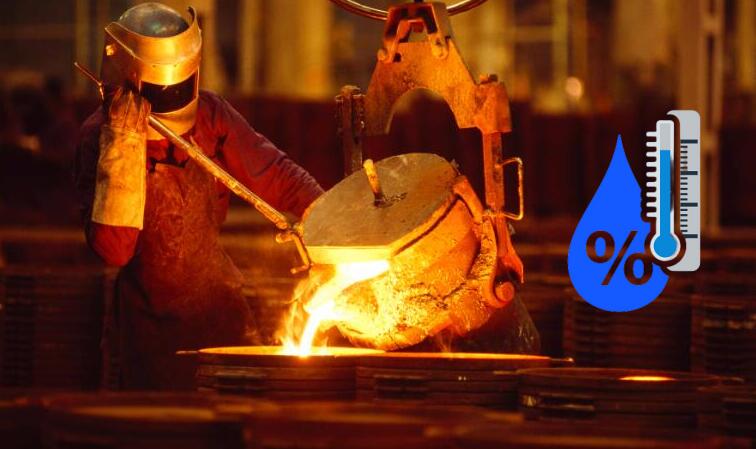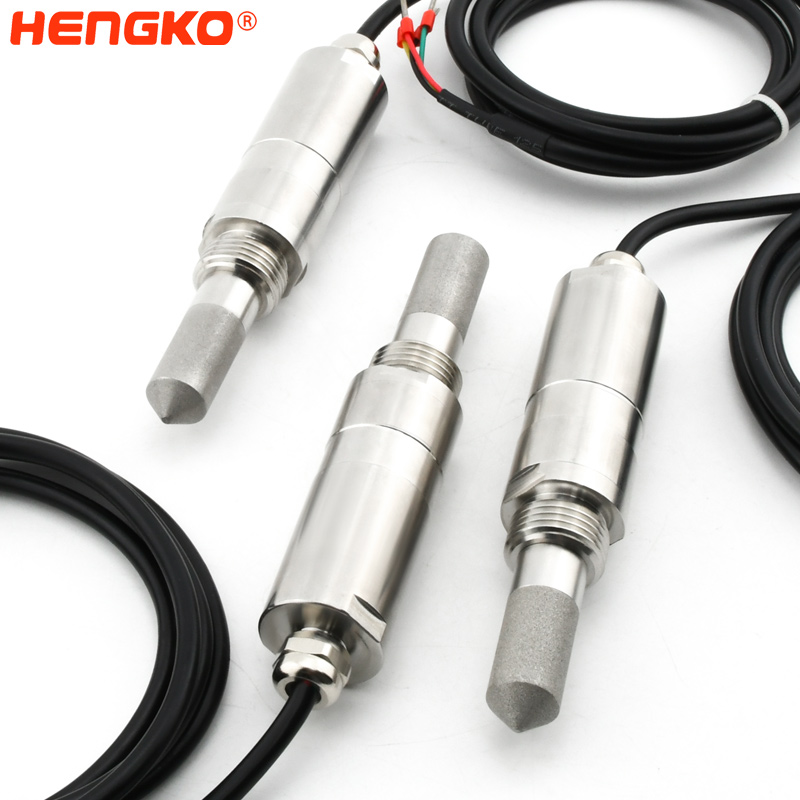
Hydrogen is widely used in bright hardening of many metals. Both hydrogen purity and humidity levels in the
gas need to be measured and controlled.
Too much moisture can reduce the strength and quality of the finished product. There are two main methods
of hydrogen transport in metallurgy --bulk hydrogen from gas cylinders and pyrolysis ammonia. Metallurgical
process moisture measurement is very important, want to know continue to see!
First, Both Delivery Methods Have Advantages and Disadvantages.
Pure hydrogen can be used immediately, but it is more expensive to buy, and storing large amounts of
hydrogen for applications poses a fire risk.
Ammonia (NH 3) is cheaper to buy in bulk and is less flammable, so it is safer to store in the field.
However, it carries its own risks: it is highly corrosive,
so factory equipment and personal safety are key concerns. Nevertheless, ammonia cracking units
are now a more common method of providing a reducing/hardening atmosphere for metallurgical
furnaces. The dissociated ammonia is a mixture of hydrogen and nitrogen and is known as a "synthetic gas".
Second, How Does Ammonia Cracking Work ?
The pressurized ammonia is heated to evaporate it. It is then broken down into its constituent parts,
hydrogen and nitrogen, by a nickel catalyst at a temperature of about 1,000 °C. The chemical equation of
the reaction is: 2NH 3A → N 2 +3H 2
Due to complete decomposition into hydrogen and nitrogen, very little under composed ammonia is left
and the resulting gas should have a very low dew point temperature (well below -30°C). The dew point
temperature measurement needs special attention, because in many cases, too high or too low
dew point temperature can affect the quality of the product. In addition to the metallurgical industry,
compressed air systems are more important for dew point. HENGKO 608 dew point transmitter provides
long-term stability and rapid response to humidity changes.
HENGKO's high volume manufacturing capability makes it suitable for OEM and system integrators
who need short and consistent lead times.
The molecular sieve absorbs the last trace of uncracked ammonia still present in the gas. The gas can
also be further dried using a heated regenerative dual-column desiccant-dryer, where the gas eventually
leaves the system dryer at temperatures below -65°Cdp and consists of 75 Vol% hydrogen and
25 Vol% nitrogen.
Third, Synthetic gas (decomposition of ammonia) application
Synthetic gases are used in conveyer and tube furnaces for annealing processes in reducing atmospheres,
such as brazing, sintering, deoxidation and nitride.
Fourth, Monitor the trace moisture in the dissociated ammonia
Constant dew point meter can be used online or spot check the moisture in the air measurement. Suitable
for measurement in locations where there is no danger zone classification. This is common in many furnace
applications. A high-speed, portable dew-point hygrometer for rapid spot check measurements of dew point
or moisture content in compressed air, natural gas, quenched gas in high pressure switch gear, and many
other applications. The sensor responds quickly to changes in humidity from dry to wet or wet to dry. This
means there is no waiting between measurements and the operator can take more measurements in a day.
How Measurement of Humidity and Moisture in Metallurgical Processes
Humidity and moisture play a crucial role in many metallurgical processes. Their accurate measurement ensures product quality, reduces energy consumption, and maintains safety. Moisture can cause defects in metal products, lead to oxidation or corrosion, and alter the properties of materials.
1. Importance of Humidity and Moisture Measurement:
* Quality Control: Moisture and humidity can cause defects in metals, such as porosity, and it can also lead to oxide or scale formation on the metal surface.
* Safety: In some metallurgical processes, especially those involving powders, excess moisture can lead to agglomeration or even create explosive atmospheres.
* Energy Savings: Accurate humidity control can optimize processes, reducing energy consumption.
2. Techniques and Instruments
* Dew Point Meters: Measures the temperature at which air becomes saturated, causing water to condense. Useful for monitoring moisture in furnaces and drying systems.
* Hygrometers: Measures relative humidity directly, often used in storage and handling areas.
* Moisture Analyzers: Instruments that determine the water content in solid or liquid samples, often used in labs for quality control.
* Karl Fischer Titration: A chemical method to determine moisture content, especially in samples where very low moisture content needs to be measured.
* Infrared Moisture Analyzers: Uses infrared heating to determine moisture content by comparing the weight before and after the heating process.
3. Applications in Metallurgical Processes:
* Ore Processing: Moisture content in ores affects their handling and processing. High moisture can lead to blockages in grinding mills, while low moisture can increase dust generation.
* Pelletizing: In iron-making, the moisture content of iron ore pellets is crucial. It affects their mechanical strength and the efficiency of the reduction process in blast furnaces.
* Heat Treatment: When metals are subjected to heat treatment, the humidity and moisture in furnaces need to be controlled to achieve the desired properties and avoid surface defects.
* Powder Metallurgy: The moisture content of metal powders influences their flowability and compaction properties.
* Melting and Casting: Moisture can lead to gas porosity in the cast products. Accurate measurement ensures the molds and the melting environment are dry.
4. Control and Optimization:
* Feedback Loop: By integrating sensors in the process line, feedback can be provided to control systems for real-time optimization.
* Predictive Maintenance: With continuous monitoring, predictions about when equipment like furnaces, dryers, or dehumidifiers might fail or underperform can be made.
5. Challenges:
* Sensor Placement: In aggressive metallurgical environments, sensors need to be placed strategically to prevent damage and yet provide accurate readings.
* Calibration: Regular calibration of sensors ensures accuracy over time.
In conclusion, the measurement of humidity and moisture in metallurgical processes is vital for quality, safety, and efficiency. Through the use of advanced sensors and control systems, modern metallurgy can maintain high standards while optimizing energy and material usage.
What Kind of Humidity Transmitter Can Measurement of Humidity and Moisture in Metallurgical Processes ?
For metallurgical processes, which often involve high temperatures, aggressive atmospheres, and challenging conditions, a humidity transmitter must be robust, accurate, and resistant to environmental extremes. Several types of humidity transmitters can measure humidity and moisture in these demanding conditions:
1. High-Temperature Humidity Transmitters:
Specifically designed for high-temperature environments like furnaces, these transmitters often come with a sintered stainless steel filter to protect the sensor from particulates and splashes.
2. Ceramic-based Capacitive Sensors:
These offer good chemical resistance and can be used in corrosive environments, which might be found in some metallurgical processes.
3. Aluminum Oxide Moisture Sensors:
Primarily used for trace moisture detection in gases. These sensors work on the principle that the capacitance and conductivity of an aluminum oxide layer change in proportion to the water vapor surrounding it. They can handle very high temperatures and are often used in applications like petrochemical refineries, but they can also be suitable for some metallurgical processes.
4. Tuned Diode Laser Absorption Spectroscopy (TDLAS):
This is an advanced moisture measurement method, ideal for challenging industrial environments, including high-temperature metallurgical processes. It measures moisture concentration based on the absorption of specific light wavelengths by water molecules.
5. Zirconia-based Sensors:
Used primarily for oxygen measurement, some zirconia sensors can be paired with other technologies to infer humidity in high-temperature environments.
6. Dew Point Transmitters:
Designed for tough industrial environments, some of these transmitters can handle elevated temperatures and aggressive atmospheres. They determine the temperature at which water vapor begins to condense, which is a direct indication of moisture content.
So after know which type humidity sensor you can use for Metallurgical Processes. So how to choose?
When selecting a humidity transmitter for metallurgical processes:
* Temperature Range:
Ensure that the transmitter can operate effectively within the temperature range of your process.
* Accuracy:
Depending on the sensitivity of your process to moisture, you might need a highly accurate sensor or something more general.
* Response Time:
For some processes, especially where conditions can change rapidly, a fast response time is crucial.
* Resistance to Contaminants:
In metallurgical settings, the presence of dust, particles, or corrosive substances can interfere with measurements. Ensure the chosen transmitter is resilient to these.
* Calibration and Maintenance:
Depending on the environment, the transmitter might need frequent calibration or maintenance. Opt for devices that can be calibrated in-situ if frequent checks are required.
* Communication and Integration:
Ensure the transmitter's output can be easily integrated into your process control systems.
* Durability and Longevity:
Given the investment in these devices and the critical nature of metallurgical processes, opt for established brands and models with a track record of durability.
Always consult with manufacturers or specialists when selecting a humidity transmitter for specific metallurgical applications. They can provide insights into the best choice based on your unique needs.
Also You Can Send Us Email Directly As Follow : ka@hengko.com
We Will Send Back With 24-Hours, Thanks for Your Patient !
Send your message to us:
Post time: Jun-13-2022





